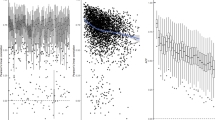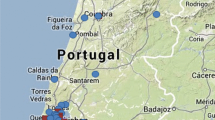Abstract
Given pollution measurement from a network of monitoring sites in the area of a city and over an extended period of time, an important problem is to identify the spatial and temporal structure of the data. In this paper we focus on the identification and estimate of a statistical non parametric model to analyse the SO2 in the city of Padua, where data are collected by some fixed stations and some mobile stations moving without any specific rule in different new locations. The impact of the use of mobile stations is that for each location there are times when data was not collected. Assuming temporal stationarity and spatial isotropy for the residuals of an additive model for the logarithm of SO2 concentration, we estimate the semivariogram using a kernel-type estimator. Attempts are made to avoid the assumption of spatial isotropy. Bootstrap confidence bands are obtained for the spatial component of the additive model that is a deterministic function which defines the spatial structure. Finally, an example is proposed to design an optimal network for the mobiles monitoring stations in a fixed future time, given all the information available.
Similar content being viewed by others
References
Arbia G, Lafratta G (2002) Anisotropic spatial sampling designs for urban pollution. Applied Statistics 51:223–234
Bowman AW, Azzalini A (1997) Applied smoothing techniques for data analysis. Oxford University Press, Clarendon
Buja A, Hastie TJ, Tibshirani RJ (1989) Linear smoothers and additive models (with discussion). The Annals of Statistics 17:453–555
Cleveland WS (1979) Robust locally-weighted regression and smoothing, scatterplots. Journal of the American Statistical Association 83: 597–610
Cleveland WS, Devlin SJ, Grosse EH (1988) Regression by local fitting: methods, properties and computational algorithms. Journal of Econometrics 37:87–114
Cressie N (1985) Fitting variogram models by weighted least squares. Journal of the International Association for Mathematical Geology 17:563–586
Cressie N (1993) Statistics for spatial data. Wiley, New York
De Cesare L, Myers DE, Posa D (2001) Estimating and, modeling space-time correlation structures. Statistics & Probability Letters 51: 9–14
De Iaco S, Myers DE, Posa D (2002) Space-time variograms and a functional form for total air pollution measurements. Computational Statistics & Data Analysis 41: 311–328
Diggle PJ, Tawn JA, Moyeed RA (1998) Model-based geostatistics (with discussion). Applied Statitics 47: 299–350
Efron B, Tibshirani RJ (1993) An introduction to the bootstrap. Chapman & Hall, New York
Hastie TJ, Tibshirani RJ (1990) Generalized additive models. Chapman & Hall, London
Hoaglin DC, Mosteller F, Tukey JW (1985) Exploring data tables, trends, and shapes. Wiley, New York
Journel AG (1980) The lognormal approach to predicting local distribution of selective mining unit grades. Mathematical Geology 12: 285–303
Journel AG, Huijbregts CJ (1978) Mining geostatistics. Academic Press, London
Kammann EE, Wand MP (2003) Geoadditive models. Applied Statistics 52: 1–18
Kunsh HR (1989) The stationary jackknife and the bootstrap for general stationary observations. The Annals of Statistics 17: 1217–1241
Kyriakidis PC, Journel AG (1999) Geostatistical space-time models: A review. Mathematical Geology 31: 651–684
Loader C, Switzer P (1992) Spatial covariance estimation for monitoring data. In: Walden AT, Guttorp P (eds) Statistics in Environmental and Earth Sciences. Edward Arnold, London, pp 52–70
Myers DE, Journel A (1990) Variograms with zonal anisotropies and noninvertibile kriging systems. Mathematical Geology 22: 779–785
Rouhani S, Myers DE (1990) Problems in space-time kriging of hydrogeological data. Mathematical Geology 22: 611–623
Scarpa B (2002) Analisi della concentrazione di SO2 combinando i dati raccolti da centraline fisse e mobili: un modello state space. Statistica 61: 707–730
Author information
Authors and Affiliations
Rights and permissions
About this article
Cite this article
Scarpa, B. Non parametric space-time modeling of SO2 in presence of many missing data. Statistical Methods & Applications 14, 67–82 (2005). https://doi.org/10.1007/BF02511575
Issue Date:
DOI: https://doi.org/10.1007/BF02511575




